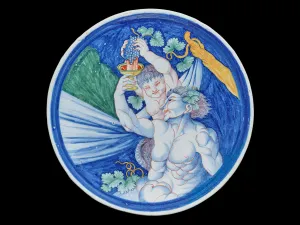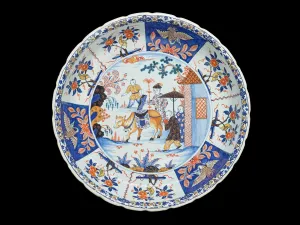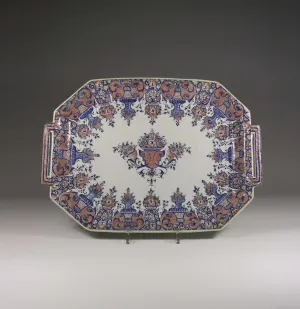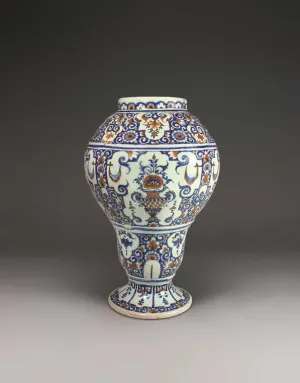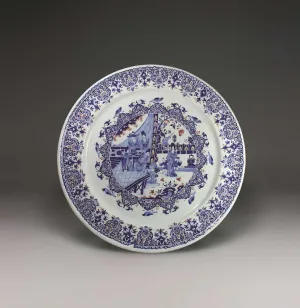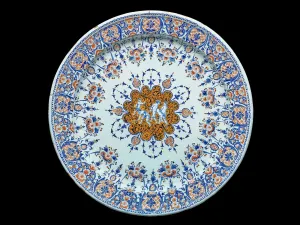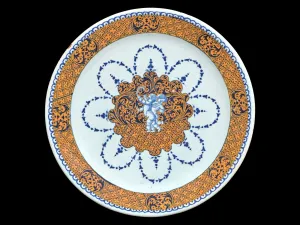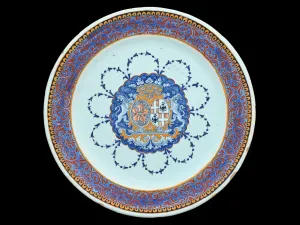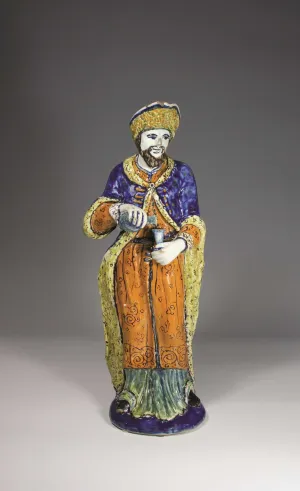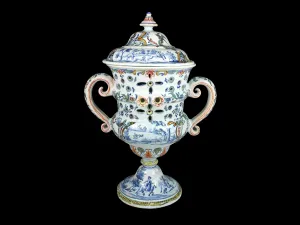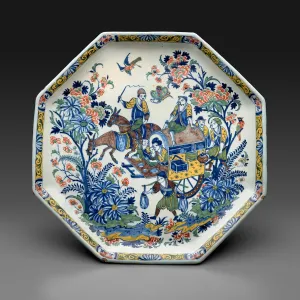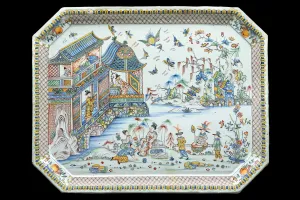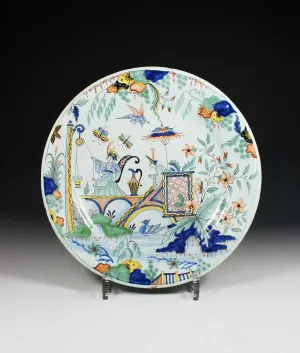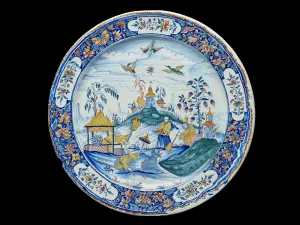Rouen: The Capital of French Faience
During the first half of the eighteenth century, Rouen was a major center of faience production in Europe with up to fourteen manufactories operating simultaneously. The city’s production of faience was initially influenced by the fashionable monochrome blue decoration developed in Nevers and Delft, depicting pastoral or chinoiserie scenes, as seen in the central scene of the large platter (cat. 31). It is surrounded by two decorative borders imitating embroidery, called lambrequins. This new type of decoration derived from the habit of late sixteenth- and seventeenth-century Chinese potters of placing a piece of embroidery around the neck of porcelain vases. Chinese potters later decorated export porcelain with motifs inspired by such pieces of embroidery, and subsequently Delft, Nevers, and Rouen potters started to do the same. It was in Rouen that this decorative ornament gained distinction and became the signature of faience produced in that city until the mid-eighteenth century.
These pieces demonstrate the varied ways in which the lambrequin motif was used in Rouen — sometimes covering an entire piece (cats. 29, 30, 35) and other times used in simple or multiple borders, thick or thin, surrounding a painted scene, small figures of children, bouquets of flowers, or coats of arms (cats. 28, 31, 32, 33). The motif appears in monochrome blue (cat. 31), blue and red (cats. 28, 29, 30), or polychromy (cats. 32, 33). Lambrequins are often combined with ocre niellé (inlaid ochre), the rarest and most prestigious type of decoration developed in Rouen (cats. 32, 33, 34, 35). Blue foliage is painted on an ochre ground to create a decorative effect that simulates the silversmith’s technique of niellage (niello), a process in which black enamel is inlaid on precious metal.
Dish
Rouen, ca. 1725−30
Painted by Pierre II Chapelle
Faience (tin-glazed earthenware)
Diam. 12 in. (30.4 cm)
Cat. 37
© The Frick Collection
Because so few faience painters signed their pieces, attributions to a specific artist are almost impossible. One exception is Pierre II Chapelle (1695−1730), whose father was also an important faience painter in Rouen. Pierre II Chapelle signed a few pieces painted in a distinctive, virtuosic style after contemporary French engravings.
Dish
Rouen, ca. 1730−40
Faience (tin-glazed earthenware)
Diam. 13 in. (33 cm)
Cat. 41
© The Frick Collection
As elsewhere in Europe, the import of Japanese lacquers, textiles, and porcelain left an important mark on potters in Rouen. This dish is influenced by Japanese Imari porcelain, characterized by extensive floral motifs painted in radiant blue and iron-red, and gold, although the central scene likely derives from a Chinese model.
Tray
Rouen, ca. 1740−50
Faience (tin-glazed earthenware)
H. 17 7/8 in. (45.5 cm), W. 20 1/4 (51.4 cm)
Cat. 45
© The Frick Collection
The quality of the painting and the varied types of decoration that developed in Rouen during the first half of the eighteenth century are further exemplified by this tray featuring a peasant scene in the manner of the seventeenth-century Flemish painter David Teniers the Younger.
Tray
Rouen, ca. 1700−20
Faience (tin-glazed earthenware)
H. 12 1/2 in. (31.8 cm), W. 17 7/8 in. (45.3 cm)
Cat. 28
© Christophe Perlès
Pair of Vases
Rouen, ca. 1710−20
Faience (tin-glazed earthenware)
H. 11 1/4 in. (28.5 cm), W. 9 3/4 in. (25 cm)
Cat. 29
© The Frick Collection
Vase
Rouen, ca. 1710−20
Faience (tin-glazed earthenware)
H. 7 7/8 in. (20 cm), W. 5 in. (12.7 cm)
Cat. 30
© Christophe Perlès
Platter
Faience (tin-glazed earthenware)
Rouen, ca. 1710−20
Diam. 21 1/4 in. (54 cm)
Cat. 31
© Christophe Perlès
Platter
Rouen, ca. 1725
Faience (tin-glazed earthenware)
Diam. 21 1/4 in. (54 cm)
Cat. 32
© Christophe Perlès
Platter
Rouen, ca. 1725
Faience (tin-glazed earthenware)
Diam. 21 5/8 in. (55 cm)
Cat. 33
© The Frick Collection
Plate
Rouen, ca. 1725
Faience (tin-glazed earthenware)
Diam. 9 5/8 in. (24.5 cm)
Cat. 34
© The Frick Collection
Covered Vase
Rouen, ca. 1725
Faience (tin-glazed earthenware)
H. 12 in. (31.5 cm), W. 9 1/2 in. (24 cm)
Cat. 35
© Christophe Perlès
Plate with Coat-of-Arms of the Marquis de Saint-Evremont
Rouen, ca. 1725
Faience (tin-glazed earthenware)
Diam. 9 1/2 in. (24 cm)
Cat. 36
© The Frick Collection
Anthropomorphic Pitcher
Rouen, ca. 1730
Faience (tin-glazed earthenware)
H. 15 7/8 in. (40.3 cm), W. 6 in. (15.2 cm)
Cat. 38
© Christophe Perlès
Wall Bracket
Rouen, ca. 1740−50
Faience (tin-glazed earthenware)
H. 12 1/2 in. (32 cm), W. 12 in. (30.5 cm)
Cat. 46
© Christophe Perlès
This bracket is one of the most accomplished pieces made in Rouen in the exuberant rocaille style fashionable in France about 1730–50. The style was inspired by nature, especially shells, and the composition was typically asymmetrical. The central scene here depicts the beginning of a famous licentious tale by Jean de la Fontaine (1621−95) in which a flighty husband seduces a pretty serving girl as she is gathering flowers in his garden, while a neighbor observes the scene from her window.
Covered Puzzle Vase
Rouen, ca. 1740
Faience (tin-glazed earthenware)
H. 12 in. (30.5 cm), W. 7 1/4 in. (18.4 cm)
Cat. 44
© Christophe Perlès
A puzzle jug — with its typical perforated neck here in the shape of flowers — was technically challenging to make as it was designed so as not to spill its contents through the holes. This covered example is particularly charming, with a surprise rooster placed inside.
Tazza
Rouen, ca. 1730
Faience (tin-glazed earthenware)
H. 6 1/4 in. (15.8 cm), diam. 11 5/8 in. (29.5 cm)
Cat. 39
© The Frick Collection
Tray
Rouen, ca. 1730−40
Faience (tin-glazed earthenware)
H. 18 in. (46 cm), W. 22 3/4 in. (58 cm)
Cat. 40
© The Frick Collection
Plate
Rouen, ca. 1730−40
Faience (tin-glazed earthenware)
Diam. 9 3/4 in. (24.6 cm)
Cat. 42
© Christophe Perlès
Platter
Rouen, 1738
Faience (tin-glazed earthenware)
Diam. 22 1/2 in. (57 cm)
Marks: on the reverse, 1738
Cat. 43
© The Frick Collection

